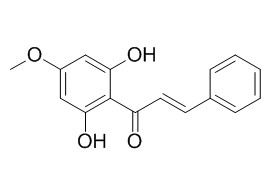Pinostrobin chalcone
Pinostrobin chalcone is a potent inhibitor of triglyceride accumulation, it can inhibit adipogenesis in 3T3-L1 cells, it may have anti-obesity effects through the inhibition of adipogenesis. Pinostrobin chalcone displays very remarkable cytotoxic activity against the human cancer cells, such as KB, MCF7 and Caski cells (IC50 values of 6.2, 7.3 and 7.7 ug/mL, respectively).
Inquire / Order:
manager@chemfaces.com
Technical Inquiries:
service@chemfaces.com
Tel:
+86-27-84237783
Fax:
+86-27-84254680
Address:
1 Building, No. 83, CheCheng Rd., Wuhan Economic and Technological Development Zone, Wuhan, Hubei 430056, PRC
Providing storage is as stated on the product vial and the vial is kept tightly sealed, the product can be stored for up to
24 months(2-8C).
Wherever possible, you should prepare and use solutions on the same day. However, if you need to make up stock solutions in advance, we recommend that you store the solution as aliquots in tightly sealed vials at -20C. Generally, these will be useable for up to two weeks. Before use, and prior to opening the vial we recommend that you allow your product to equilibrate to room temperature for at least 1 hour.
Need more advice on solubility, usage and handling? Please email to: service@chemfaces.com
The packaging of the product may have turned upside down during transportation, resulting in the natural compounds adhering to the neck or cap of the vial. take the vial out of its packaging and gently shake to let the compounds fall to the bottom of the vial. for liquid products, centrifuge at 200-500 RPM to gather the liquid at the bottom of the vial. try to avoid loss or contamination during handling.
Food Sci Biotechnol.2024, 33(15):3629-3637.
Journal of Ginseng Research2021, 25 November
Cell Prolif.2021, 54(8):e13083.
Applied Biological Chemistry2024, 67:66.
Int J Mol Sci.2020, 21(19),7070.
Process Biochemistry2019, 85:106-115
Integr Med Res.2017, 6(4):395-403
Int J Mol Sci.2022, 23(23):15213.
Phytomedicine.2018, 41:62-66
Ulm University Medical Center2020, doi: 10.18725.
Related and Featured Products
2',6'-Dihydroxy 4'-methoxydihydrochalcone
Catalog No: CFN70346
CAS No: 35241-55-5
Price: Inquiry(manager@chemfaces.com)
Pinostrobin chalcone
Catalog No: CFN99878
CAS No: 18956-15-5
Price: $368/20mg
Cardamonin
Catalog No: CFN99890
CAS No: 19309-14-9
Price: $40/20mg
Flavokawain B
Catalog No: CFN92661
CAS No: 1775-97-9
Price: $158/20mg
Dihydropashanone
Catalog No: CFN97741
CAS No: 41997-41-5
Price: Inquiry(manager@chemfaces.com)
Pashanone
Catalog No: CFN98661
CAS No: 42438-78-8
Price: Inquiry(manager@chemfaces.com)
2',4'-Dihydroxy-3',6'-dimethoxydihydrochalcone
Catalog No: CFN98908
CAS No: 54299-52-4
Price: Inquiry(manager@chemfaces.com)
2',4'-Dihydroxy-3',6'-dimethoxychalcone
Catalog No: CFN99391
CAS No: 129724-43-2
Price: Inquiry(manager@chemfaces.com)
2'-Hydroxy-3',4',6'-trimethoxychalcone
Catalog No: CFN91489
CAS No: 91856-16-5
Price: Inquiry(manager@chemfaces.com)
2'-Hydroxy-4,3',4',6'-tetramethoxychalcone
Catalog No: CFN91409
CAS No: 91856-17-6
Price: Inquiry(manager@chemfaces.com)
J Nat Med. 2016 Jul;70(3):502-9.
Inhibitory effects of compounds isolated from the dried branches and leaves of murta (Myrceugenia euosma) on lipid accumulation in 3T3-L1 cells.[Pubmed:
26880616 ]
As obesity is a global health concern the demand for anti-obesity drugs is high. In this study, we investigated the anti-obesity effect of the dried branches and leaves of murta (Myrceugenia euosma Legrand, Myrtaceae).
METHODS AND RESULTS:
A methanol extract of the dried branches and leaves of murta inhibited adipogenesis in 3T3-L1 cells. Three known flavanones-cryptostrobin (1), pinocembrin (4), and 5,7-dihydroxy-6,8-dimethylflavanone (6), and three chalcones-2',6'-dihydroxy-3'-methyl-4'-methoxychalcone (2), Pinostrobin chalcone (3), and 2',6'-dihydroxy-4'-methoxy-3',5'-dimethylchalcone (5) were isolated from the active fraction. Structures of these compounds were identified using various spectral data. Each of these compounds also inhibited adipogenesis in 3T3-L1 cells. In particular, compound 3 was a more potent inhibitor of triglyceride accumulation than the positive control berberine. Gene expression studies revealed that treatment of 3T3-L1 cells with 3 lowers the expression levels of CCAAT/enhancer-binding protein α and peroxisome proliferator activator γ2 during adipogenesis without affecting cell viability. Treatment of 3T3-L1 cells with 3 reduced the expression levels of mRNAs encoding sterol regulatory element-binding protein 1c and several lipogenic enzymes, including fatty acid synthase and stearoyl CoA desaturase-1.
CONCLUSIONS:
These results indicate that the methanol extract and compounds isolated from the dried branches and leaves of murta exert their anti-obesity effects through the inhibition of adipogenesis.
Molecules. 2011 Jan 14;16(1):583-9.
Phytochemical and cytotoxic investigations of Alpinia mutica rhizomes.[Pubmed:
21240148]
The methanol and fractionated extracts (hexane, ethyl acetate and water) of Alpinia mutica (Zingiberaceae) rhizomes were investigated for their cytotoxic effect against six human carcinoma cell lines, namely KB, MCF7, A549, Caski, HCT116, HT29 and non-human fibroblast cell line (MRC 5) using an in vitro cytotoxicity assay.
METHODS AND RESULTS:
The ethyl acetate extract possessed high inhibitory effect against KB, MCF7 and Caski cells (IC₅₀ values of 9.4, 19.7 and 19.8 µg/mL, respectively). Flavokawin B (1), 5,6-dehydrokawain (2), Pinostrobin chalcone (3) and alpinetin (4), isolated from the active ethyl acetate extract were also evaluated for their cytotoxic activity. Of these, Pinostrobin chalcone (3) and alpinetin (4) were isolated from this plant for the first time.
CONCLUSIONS:
Pinostrobin chalcone (3) displayed very remarkable cytotoxic activity against the tested human cancer cells, such as KB, MCF7 and Caski cells (IC₅₀ values of 6.2, 7.3 and 7.7 µg/mL, respectively). This is the first report of the cytotoxic activity of Alpinia mutica.
3,3',4',5,6,7,8-heptamethoxyflavone
Catalog No: CFN95021
CAS No: 1178-24-1
Price: $268/10mg
Quercetin 3-O-beta-(6''-p-coumaroyl)glucopyranosyl(1->2)-alpha-L-rhamnopyranoside
Catalog No: CFN95088
CAS No: 143061-65-8
Price: $338/10mg
Microgrewiapine A
Catalog No: CFN95125
CAS No: 1420777-30-5
Price: $413/5mg
Leachianol F
Catalog No: CFN95147
CAS No: 164123-50-6
Price: $318/5mg
New compound 4
Catalog No: CFN95185
CAS No: N/A
Price: $368/5mg
Safflospermidine A
Catalog No: CFN95255
CAS No: 1111082-13-3
Price: $413/5mg
Euphorbia factor L22
Catalog No: CFN95338
CAS No: 1613700-09-6
Price: $413/5mg
Dioscoreside E
Catalog No: CFN95346
CAS No: 435321-73-6
Price: $318/5mg
12beta-Acetoxy-3,7,11,15,23-pentaoxo-lanost-8,20-dien-26-oic acid
Catalog No: CFN95505
CAS No: 1309931-91-6
Price: $318/5mg
Ganolucidic acid E
Catalog No: CFN95536
CAS No: 114567-50-9
Price: $318/5mg



